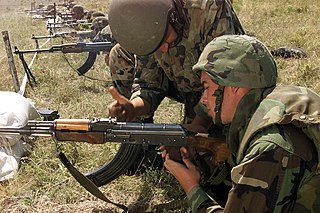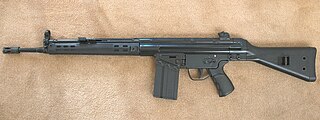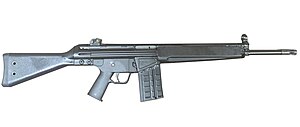
A carbine is a long gun that has a barrel shortened from its original length. Most modern carbines are rifles that are compact versions of a longer rifle or are rifles chambered for less powerful cartridges.

A firearm is any type of gun that uses an explosive charge and is designed to be readily carried and used by an individual. The term is legally defined further in different countries.

Heckler & Koch GmbH is a German armaments manufacturing company that manufactures handguns, rifles, submachine guns, and grenade launchers. The company is located in Oberndorf am Neckar in the German state of Baden-Württemberg, and also has subsidiaries in the United Kingdom, France and the United States.

A squad automatic weapon (SAW), also known as a section automatic weapon or light support weapon (LSW), is a man-portable automatic firearm attached to infantry squads or sections as a source of rapid direct firepower. Weapons fulfilling this role can be light machine guns, or modified selective-fire rifles fitted with a heavier barrel, bipod and a belt/drum-fed design.
The FN FAL is a battle rifle designed in Belgium in 1953 by Dieudonné Saive and manufactured by FN Herstal.

The Colt AR-15 is a lightweight, magazine-fed, gas-operated semi-automatic rifle. It is a semi-automatic version of the M16 rifle sold for the civilian and law enforcement markets in the United States. The AR in AR-15 stands for ArmaLite rifle, after the company that developed it in the 1950s. Colt's Manufacturing Company currently owns the AR-15 trademark, which is used exclusively for its line of semi-automatic AR-15 rifles.

The M203 is a single-shot 40 mm under-barrel grenade launcher designed to attach to a rifle. It uses the same rounds as the older stand-alone M79 break-action grenade launcher, which utilizes the high-low propulsion system to keep recoil forces low. While compatible with many weapons, the M203 was originally designed and produced by the United States military for the M16 rifle and its carbine variant, the M4. The launcher can also be mounted onto a C7, a Canadian version of the M16 rifle; this requires the prior removal of the bottom handguard.

The Heckler & Koch G3 is a 7.62×51mm NATO, select-fire battle rifle developed in the 1950s by the German armament manufacturer Heckler & Koch (HK) in collaboration with the Spanish state-owned design and development agency Centro de Estudios Técnicos de Materiales Especiales (CETME). The modular designed G3 has over the years been exported to over 70 countries and manufactured under licence in at least 15 countries, bringing the total number built to around 7,800,000.
The Springfield Armory M1A is a semi-automatic rifle made by Springfield Armory, Inc., beginning in 1971, based on the M14 rifle, for the civilian and law enforcement markets in the United States. "M1A" is a proprietary name for Springfield Armory's M14-pattern rifle. Early M1A rifles were built with surplus G.I. parts until Springfield Armory, Inc. began manufacturing their own. Robert Reese bought Springfield Armory from Elmer Ballance, and moved the manufacturing to Geneseo Ill in 1974.

The Heckler & KochXM8 is a lightweight assault rifle system developed from the late 1990s to early 2000s. The rifle was designed by German small arms manufacturer Heckler & Koch (H&K), and shares design and engineering with their G36 rifle.

The Beta C-Mag is a 100-round capacity drum magazine manufactured by the Beta Company. It was designed by Jim Sullivan and first patented in 1987 and has been adapted for use in numerous firearms firing the 5.56×45mm NATO, 7.62×51mm NATO, and 9×19mm Parabellum cartridges. C-Mag is short for century magazine, referring to its 100-round capacity. It has two drum units, each of which hold half of the cartridges inserted into the magazine. The latest version of the magazine is available with a transparent backing to allow the user to see the number of rounds remaining in the magazine. A C-Mag loaded with 5.56×45mm NATO ammunition typically weighs about 2.1 kg (4.63 lb); a C-Mag loaded with 7.62×51mm NATO ammunition weighs 4.77 kg (10.5 lb).

The Heckler & Koch HK33 is a 5.56mm assault rifle developed in the 1960s by West German armament manufacturer Heckler & Koch GmbH (H&K), primarily for export.

The Bushmaster M4 or M4A3 is a semi-automatic or select-fire carbine manufactured by Bushmaster Firearms International, modeled on the AR-15. It is one of the Bushmaster XM15 line of rifles and carbines.

The Heckler & Koch HK41 is a semi-automatic version of the Heckler & Koch G3 battle rifle; it was produced by Heckler & Koch for the civilian market in the 1960s. It is not to be confused with the similarly titled Heckler & Koch G41. The HK41 was distinctive in its class because it didn't have a gas-operated mechanism. It instead had a roller-delayed blowback system based on two roller cams that delayed cycling action without mechanical tilting or rotation. Another unique feature of the HK41 was a fluted chamber which had longitudinal grooves machined into it that gave ejected brass the appearance of having been slugged through a barrel with no-twist rifling. The fluting reduced friction between the cartridge and chamber as the roller-block mechanism began cycling.

The Heckler and Koch SR9 is a series of hunting and target rifles derived from the Heckler & Koch HK91 incorporating parts from the PSG1 and MSG-90 marksman rifles.

The M6 is a series of carbines designed and manufactured by LWRC International. It is based on the M4 carbine, with which it shares 80% of its parts. The 'M' model name is not a US military designation. Like the HK416, it features a proprietary short-stroke self-regulating gas piston system and bolt carrier/carrier key design, which prevents trapped gases from contacting the bolt carrier or receiver of the weapon. The manufacturer claims that this reduces the heating and carbon fouling of the internals, simplifies field maintenance, and improves reliability.
The evolution of German military rifles is a history of common and diverse paths followed by the separate German states, until the mid-19th century when Prussia emerged as the dominant state within Germany and the nation was unified. This article discusses rifled shoulder arms developed in or for the military of the states that later became Germany; it excludes firearms of the Austrian Empire, except where they were used substantially by German troops.
The FN FNC is a 5.56×45mm NATO assault rifle developed by the Belgian arms manufacturer FN Herstal and introduced in the late 1970s.
The FB MSBS Grot is a family of modular assault rifle developed and manufactured by FB "Łucznik" Radom. Early prototypes were known as the MSBS-5.56 Radon.

The Heckler & Koch HK433 is a modular assault rifle chambered for 5.56×45mm which combines features of the G36 and the HK416 families of assault rifles.















